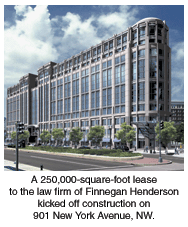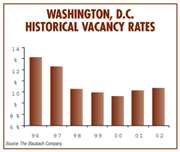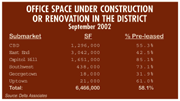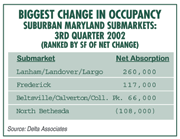The District Maintains Strength Throughout 2002
David Houck, Robb Johnson and Peter Brohoski
 The
impact of September 11, 2001, on the Washington, D.C., real estate market
has been closely monitored over the past year. The federal government’s
increased scrutiny of location and building security, federal agencies’
administrative and departmental reformulations under the Office of Homeland
Security, and the private sector tenant’s general reactions to doing
business in downtown Washington have all contributed to a very anxious
real estate environment throughout the past year. At one point, market
participants were even unsure whether private sector office buildings
located in close proximity to important federal buildings would lose their
economic viability. The
impact of September 11, 2001, on the Washington, D.C., real estate market
has been closely monitored over the past year. The federal government’s
increased scrutiny of location and building security, federal agencies’
administrative and departmental reformulations under the Office of Homeland
Security, and the private sector tenant’s general reactions to doing
business in downtown Washington have all contributed to a very anxious
real estate environment throughout the past year. At one point, market
participants were even unsure whether private sector office buildings
located in close proximity to important federal buildings would lose their
economic viability.
Despite an anxious tenant base and relatively softening demand, Washington,
D.C., continued to show stability compared to other major metropolitan
markets. While the General Services Administration continues to take center
stage in its quest for space, the private sector holds its own. Notable
private sector transactions include the law firm of Finnegan Henderson,
which leased 250,000 square feet to kick off the construction of 901 New
York Avenue; CareFirst committed to a 240,000-square-foot build-to-suit
office building in the Capitol Hill submarket; and the law firm of O’Melveny
& Myers leased close to 120,000 square feet in the central business
district (CBD).
At 6.8 percent, Washington continues to boast the healthiest market with
the lowest vacancy rate among all major U.S. markets. And while demand
has softened over the past year, vacancy has risen only approximately
1.5 percent since last fall. Through the first three quarters of 2002,
absorption in the District has reached over 600,000 square feet, primarily
due to the delivery of more than 900,000 square feet of new space. Absorption
for sublease and re-lease space actually measures negative 400,000 square
feet through the first three quarters of 2002.
 Despite
the slightly softer market conditions, rents have not moved downward significantly.
Average asking full service rents for Class A space are just over $38
per square foot, with trophy space averaging $49.25 per square foot. Average
asking full service rents for Class B space have reached $32.90 per square
foot, up slightly from year-end 2001. Concessions such as free rent and
moving allowances are typically still not being included in deal structures. Despite
the slightly softer market conditions, rents have not moved downward significantly.
Average asking full service rents for Class A space are just over $38
per square foot, with trophy space averaging $49.25 per square foot. Average
asking full service rents for Class B space have reached $32.90 per square
foot, up slightly from year-end 2001. Concessions such as free rent and
moving allowances are typically still not being included in deal structures.
In terms of new construction, four buildings have delivered close to 1
million square feet so far in 2002 and an additional 650,000 square feet
of new construction is scheduled to deliver by year-end. While 70 percent
of the space that has been delivered so far in 2002 was leased upon delivery,
only a modest amount of pre-leasing has been completed on construction
projects that broke ground in the first half of 2002. A relatively low
vacancy rate and steady demand for large blocks of space have kept developers
bullish on new construction for the foreseeable future.
 Several
major projects are currently underway that will significantly enhance
the already flourishing “24-hour” magnetism of Washington. For
starters, construction of the new $800 million convention center, which
will help re-establish Washington, D.C., as a major convention destination,
is scheduled to deliver by April 2003. The Washington, D.C., Convention
and Tourism Corporation (WCTC) reports that 166 conventions are booked
through 2013. According to the WCTC, that represents 3.1 million hotel
room nights in D.C. and translates into nearly $1.5 billion in direct
spending in Washington. Several
major projects are currently underway that will significantly enhance
the already flourishing “24-hour” magnetism of Washington. For
starters, construction of the new $800 million convention center, which
will help re-establish Washington, D.C., as a major convention destination,
is scheduled to deliver by April 2003. The Washington, D.C., Convention
and Tourism Corporation (WCTC) reports that 166 conventions are booked
through 2013. According to the WCTC, that represents 3.1 million hotel
room nights in D.C. and translates into nearly $1.5 billion in direct
spending in Washington.
Tenant Opportunities in Suburbs
Suburban vacancy rates inside the Beltway hover at or slightly lower than
10 percent, which is relatively favorable compared to conditions in the
outlying markets in Maryland and Virginia. Vacancy rates in Virginia outside
the Beltway, with special emphasis on points west like Reston and Herndon,
remain very high (as much as 35 percent). These high rates were generated
by the collapse of some of the largest portions of the tenant base —
the telecommunications and Internet companies, the most recent being WorldCom.
As a result, there are many millions of square feet available along the
Dulles Toll Road. Furthermore, the Virginia markets represent a historic
buyers’ opportunity for lease tenants not seen since the late 1980s/early
1990s.
 Market
conditions in the suburban Maryland market are not as depressed as Virginia
in terms of vacancy rates, but currently suffer from low demand and slow
market activity. In Northern Virginia, the market sectors with active
office leasing requirements include the U.S. Government and government
contractors. In Montgomery County, most of the market remains fueled by
government and quasi-government initiatives as well as the continuing
strong demand from biotechnology companies in the Interstate 270 Corridor. Market
conditions in the suburban Maryland market are not as depressed as Virginia
in terms of vacancy rates, but currently suffer from low demand and slow
market activity. In Northern Virginia, the market sectors with active
office leasing requirements include the U.S. Government and government
contractors. In Montgomery County, most of the market remains fueled by
government and quasi-government initiatives as well as the continuing
strong demand from biotechnology companies in the Interstate 270 Corridor.
The Washington, D.C., sublease market offers bargains for firms that are
willing to enter into shorter-term deals. Many law firms have put blocks
of at least 10,000 square feet on the market during the past year. However,
large blocks (50,000+ square feet) of space are at a premium. Full service
rents starting in the mid-$40s per square foot are common, and increasingly,
tenants are devising plans to renew their leases due to the lack of acceptable
prime alternatives.
Unlike suburban markets, the tenant database in Washington, D.C., consists
of tenants whose business remains relatively impervious to cyclical conditions.
Associations, non-profit organizations, lobbying and public relations
firms, and government contractors never experienced the hyper growth that
technology companies did in the late 1990s. Consequently, there has been
minimal contraction, if not growth, throughout the past 2 years. The steady
demand of the tenant base, coupled with a modest amount of speculative
development, stemming from a lengthy development process and barriers
to entry given height restrictions and a dwindling supply of land, make
Washington a costly place for a tenant to conduct business.
Retail
With its northwest neighborhoods and surrounding counties boasting some
of the highest household income levels in the nation, Washington continues
to build upon its rebirth as a 24-hour city. Despite a sharp downturn
in the number of patrons dining out and shopping downtown after September
11, 2001, the city has returned to its robust 24-hour vitality, complete
with trendy new restaurants, older entrenched establishments, theaters
and new shopping venues. And several new projects under construction will
only add to the vitality.
One new project that has garnered a lot of attention is Gallery Place,
a $250 million downtown retail and entertainment complex being constructed
at Seventh and G streets, NW, next to the MCI Center. Gallery Place is
the first downtown retail project to use tax increment financing, a financing
mechanism not utilized by previous administrations. This complex will
be anchored by a 14-screen United Artists theater and will include a mix
of retail, restaurant and entertainment venues. Upon completion in the
fall of 2003, Gallery Place will further bolster the Seventh Street retail
corridor, which has already benefited from a revitalization of the storefronts
and overall streetscape. Many local and national restaurant establishments,
in addition to retailers, now line major portions of the Seventh Street
corridor. The city estimates that Gallery Place, when fully leased, will
generate nearly $10 million annually in net tax revenue.
Upon completion in 2004, this mixed-use development will be linked to
the MCI Arena via a 25- to 50-foot pedestrian promenade. Construction
on the Newseum, an interactive museum of news, is also underway at the
corner of Pennsylvania Avenue and Sixth Street. The Newseum is scheduled
to open in 2006.
Not far from the Gallery Place site, the city has begun marketing the
old convention center site, comprising 10.5 acres in the heart of the
East End submarket of Washington. The city has abandoned its plans to
put a department store on the site and instead wants to build on the retail
and residential momentum created throughout the surrounding area. The
site, which can accommodate 300,000 square feet of retail, has captured
interest from many local and national players. When complete, the planned
mix of boutique retail and restaurants will serve as a crowning achievement
in the city’s plans to revitalize retail vitality in under-served
areas of the city.
In addition to ensuring a robust urban core, city officials have been
working vigorously to bring retail operators to the more peripheral and
under-served areas of the city and it looks like those efforts are starting
to pay off.
Recently, Target announced that it may add its first D.C. location at
the USA retail development near the Columbia Heights Metro Station. In
addition, the Swedish retailer H&M announced the possibility of taking
space in the Woodies Building at 11th and G streets. As Target and H&M
begin to realize the economic value of the city, other retailers such
as Gap, Old Navy, Home Depot and Urban Outfitters have already discovered
D.C. as a flourishing retail market. As a result, retail venues are becoming
increasingly available beyond the trendy areas of Georgetown and DuPont
Circle.
Multifamily
Luxury condominiums are on the rise throughout the Washington, D.C., metropolitan
area. Eighteen 81, the tallest residential condominium in the Washington,
D.C., area, is slated for development in Northern Virginia. Curtis &
Facchina Development Company is developing Eighteen 81, which will consist
of 27 stories and 183 units in Rosslyn. Construction is expected to begin
in 2003.
Two projects in Bethesda, Maryland, are also planned. The Smart Growth
Alliance, a coalition that lends support to projects that provide alternatives
to single-use, auto-oriented design, has recently given the go-ahead on
two developments based on their transportation and environmental benefits.
The first is a development that will be constructed next to the White
Flint Metro station in North Bethesda. LCOR will develop the project,
which includes a 1.4 million-square-foot residential component that will
generate approximately 6,500 additional Metro trips to and from the White
Flint Station. Arlington East is the second development approved by The
Smart Growth Alliance. It will be built on a seven-block site owned and
redeveloped by Federal Realty Investment Trust. Arlington East will consist
of 180 rental apartments by the Bethesda Metro Station.
Class A rents in high-rise apartment buildings in Washington, D.C., average
approximately $2,100 per month. The condominium market is faring just
as well. The Lofts at Adams Morgan, developed by PN Hoffman, range in
size from 850 to 1,700 square feet. The largest unit in the building sold
for $1.2 million and has views of the Capitol from the rooftop patio.
The groundbreaking for Massachusetts Court, a luxury apartment building
going up at 300 Massachusetts Avenue, occurred recently. This $33.5 million
complex will have units averaging 900 square feet. Other residential projects
in downtown Washington, D.C., include Akridge’s Gallery Place, a
150-unit project; JPI’s planned 419 units within Jefferson at Penn
Quarter; and 145 units at the Avalon Bay community next to the MCI Center.
Industrial
The Washington, D.C., area is simply not the market for buying or selling
industrial space — the hot East Coast markets are Philadelphia ($36
per square foot with 11.3 percent yield) and Baltimore ($42 per square
foot with 10 percent yield). A recent study ranks Washington, D.C., either
at or near the bottom of the top industrial regions. Washington, D.C.,
did, however, rank ninth on the list of top buyers’ markets with
a $54 per square foot and 10.2 percent yield. The data in the study is
based on all closed transactions during the first 6 months of 2002.
Investment
Investors consistently rank the Washington, D.C., area among the nation’s
top five cities for office properties. Historically, real estate has done
well when stocks suffer. Despite Wall Street’s apprehension over
the current earnings season, the investor markets remain very strong for
high-quality investment real estate. This is in large part generated by
very low bond prices and very unstable equity markets. The aforementioned
instability generates tremendous interest in the upside potential of investment
grade commercial properties as well as the benefits of materially higher
coupon yields than are available in fixed bond instruments.
David Houck is senior vice president and managing partner of The Staubach
Company’s Washington, D.C., office; Robb Johnson is senior vice president
and managing partner of Staubach’s Virginia office; and Peter Brohoski
is vice president of Staubach Education & Municipal Services.
©2002 France Publications, Inc. Duplication
or reproduction of this article not permitted without authorization
from France Publications, Inc. For information on reprints of
this article contact Barbara
Sherer at (630) 554-6054.
|
